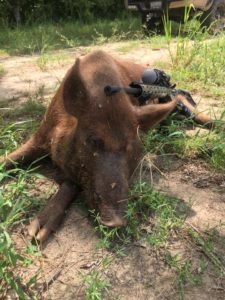 |
|
Feral Hog |
Damage Controlling
Feral hogs (Sus scrofa) are the same species as the domestic swine breeds and in Indiana primarily consist of hybrids and escaped or intentionally released domestic hogs. Feral hogs prefer the cover of dense brush for protection, but may also be found in open range and grassy areas. During hot weather they spend much of their time wallowing in ponds, springs and streams close to protective cover. Feral hogs are omnivorous and will eat anything from grain to carrion. Vegetable matter constitutes an important part of their diet. When available, acorns are preferred. They also consume roots and invertebrates (e.g., crayfish), earthworms, amphibians, reptiles, and small mammals. In certain areas cultivated crops and row crops make up a significant portion of their diet. Wild hogs also prey on young native and the young of livestock, and other smaller vertebrates (e.g., rabbits, deer fawns).
Identification
Feral Hogs
Feral hogs are domestic hogs which have escaped into the wild or have been illegally released for hunting purposes and have become free-ranging. Their size and color depend upon their breed and their nutrition during development.
European Wild Hogs
European wild hogs (often referred to as “Russian” boars) differ in appearance from feral hogs and are generally hybrids with feral hogs. The wild hog usually has longer legs, a larger head, and a longer snout. The young are reddish brown with black longitudinal stripes. As the animals mature the stripes disappear and their color changes to black. Wild hogs of all ages and sex have continuously growing tusks, in addition to multiple splits at the ends of the hair shafts, and mane from the neck to the base of the tail.
Biology and Reproduction
|
Adult weight:
|
100 to 400+ pounds. |
|
Adult height:
|
3 feet (males are generally larger than females). |
|
Color:
|
Varies from solid black, brown, blond, white, or red to spotted or belted. |
|
Feet:
|
Similar to deer tracks, except toes have more round or blunt tips. |
|
Gestation period:
|
115 days. |
|
Litter size:
|
Four to eight, but may be as large as thirteen. |
|
Number of litters:
|
1-2 litters per year, and young may be born at any time of the year. |
|
Social structure:
|
Generally travel in family groups comprised normally of two or more adult sows and the young. Boars are generally solitary, only joining a group to breed. |
Distribution
Hogs may have been first introduced into the Americas in 1498 by Christopher Columbus during his exploration of the West Indies. Hogs were introduced into Florida in 1593, eventually free-ranging populations spread into Georgia and the Carolinas and other southeastern states. Feral hogs and their hybrids were initially kept in shooting preserves for sport hunting but over time escape or were intentionally released to become established in many other states. Feral hogs have been reported in Indiana since early 1990’s. Today, feral hogs are reported primarily in southern Indiana counties.
Damage
Damage caused by feral hogs has been reported in some southern Indiana counties. Crops commonly damaged by feral hogs include wheat, corn, pastures, watermelon, and cantaloupe. One of the most common types of damage to these crops occurs when the hogs root in the fields. Hogs not only consume, but also trample and root up the crops. Feral hogs also will destroy the nests and consume the eggs of ground nesting birds such as quail and wild turkey and destroy habitats used by many species of native flora and fauna either through direct consumption, tusking, rooting, and other disturbance activities.
Control Methods
Feral hogs can be effectively controlled by snaring, trapping, shooting and hunting. There are currently no toxicants or repellents registered for the control of feral hogs.
Restrictions
In Indiana, feral hogs are considered free-ranging, exotic animals and may be taken at any time of the year by any legal means. The importation for the purpose of release, possession and relocation of live feral hogs is illegal in Indiana (see Indiana Administrative Code 312 IAC 9-3-18.5).
Acknowledgments
The information given herein is for educational purposes only. Reference to commercial products or trade names is made with the understanding that no discrimination is intended and no endorsement by State or Federal Agencies is implied. This program serves people of all ages regardless of socioeconomic level, race, color, sex, religion, disability, or national origin. The Wildlife Conflicts Information Hotline is a cooperative program of the United States Department of Agriculture – Animal and Plant Health Inspection Service – Wildlife Services, Indiana Department of Natural Resources-Division of Fish & Wildlife, and Purdue Cooperative Extension Service.